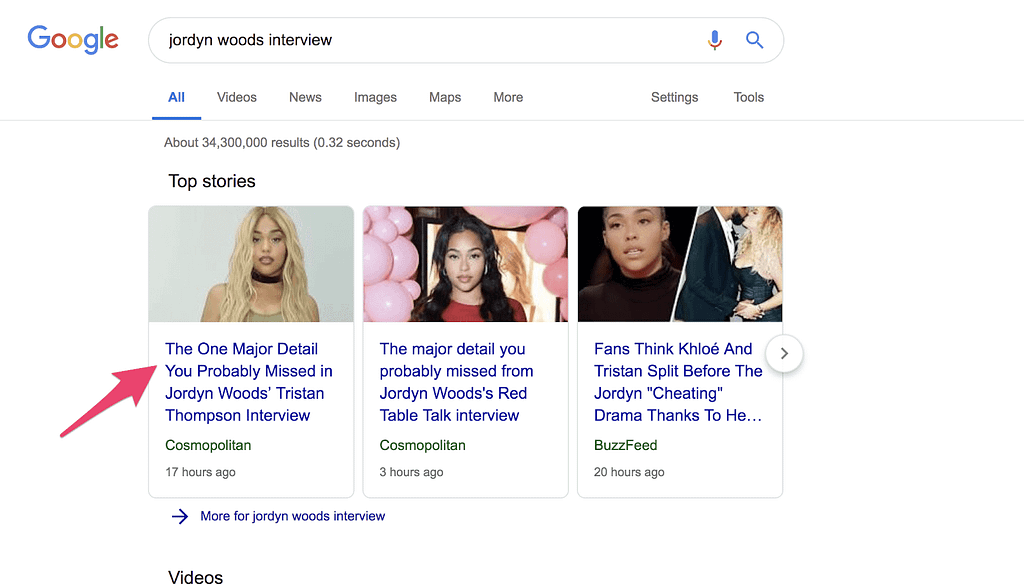Posted 05.03.2019
By Lucy Bradley
Over the past few weeks, you might have noticed a lot of talk around ‘Dwell Time’ in the world of SEO. Do you know what dwell time is? How it’s measured? Is it a ranking factor or isn’t it? More importantly, should you care about dwell time, and should you focus your SEO strategy around it? This quick and simple guide will give you the answer to these questions, and most importantly will help to give you a better idea of what SEOs are talking about in relation to dwell time. We know it can get a little confusing!
Getting straight to the point, dwell time refers to the length of time between you clicking on a search result and you returning back to the SERPs. Sounds simple enough right? Let’s look at an example:
I search for “Jordyn woods interview” (staying on top of all the Kardashian drama).

I click the first result and spend 1 minute 20 seconds reading the article. However, because I want to see if there are any more juicy details I’ve missed I want to read more content. I use my back button to go back to the SERPs. I click the next article and spend 2 minutes reading this one, getting all the latest drama.
Just to confuse you even more, going and back and forth between the SERPs is also known as pogo sticking in the SEO world. Jargon crazy – we know!
My dwell time on the first article was around 1 minute 20 seconds, whereas on the second article it was 2 minutes. My dwell time was higher on the second article because I was on the page for longer before navigating back to the SERPs. Make sense?
So now you might be thinking, isn’t dwell time just some mix of bounce rate and time on page? If there’s one thing to take from this, it’s to know that dwell time is not the same as bounce rate or time on page. It’s a metric in its own right. Just a reminder:
So whilst it might be subtle, there are differences between these three metrics. However, whilst you can find your average bounce rate or time on page in Google Analytics you won’t see a metric for dwell time.
In typical Google style, we’re not 100% sure whether dwell time is a ranking factor that they use or not. There is no official statement from Google on the matter, so we can’t say for sure. However, what we do know is that Google is using machine learning into their ranking algorithm. Whilst this has been confirmed, unfortunately it means that we still can’t say dwell time is a direct ranking factor.
One of the key arguments against why dwell time isn’t a ranking factor by Google is because it isn’t always an indication of user experience. Just because someone has a low dwell time, it doesn’t mean their experience of that page was poor. For example, think of a shopping related query. You’re clicking back and forth between results, looking for the perfect item, at the best price and with the cheapest delivery right? You’re not clicking back and forth because the pages themselves are bad, you’re just being a bargain hunter.
Similarly, some queries require a quick answer, and therefore the dwell time will be lower. Such as if you want to find out when a song was released, or what the weather is going to be like next week. Because the answer was quick to find, you’ll return to the SERPs pretty quickly. This isn’t an indication of bad user experience, in fact, it’s quite the opposite; you found the answer you were looking for as fast as possible. As we know, Google now does bring up a knowledge graph result for some queries, which does combat this issue to a certain degree. However, these don’t always give us the level of detail, or answer we’re looking for.
As we know, Google has over 200 rankings factors so there is no need to dwell on dwell time, especially when Google hasn’t confirmed it is a ranking factor, and we have no easy way to measure it. Because Google looks at so many user engagement metrics, you should really focus on providing a greater on-page user experience and writing great content for your users to read. Make sure both your content, and the keywords you decide to target are relevant to the page, and match the user’s search intent. What’s more, don’t forget about your page title and meta descriptions. People are quick to underestimate their power when really, they are what’s between a user clicking on your website to another. If you provide quality content and a quality on-page experience you’ll naturally lower dwell time, lower your bounce rate and increase your average on page duration; which all look great in Google’s eyes!
Our Services
Recent posts
The Beginner’s Guide to Setting Up Your First eCommerce Store
Posted 25/03/2025 by Frogspark
How to Create Cost-Effective, Engagement-Boosting Videos For Your Website
Posted 11/02/2025 by Frogspark
Building Better Website Forms To Drive More Conversions (and Revenue)
Posted 27/01/2025 by Pete Bingham
Need help with your web design or digital marketing?
Talk to an expert today or call us on 01332 493766
Part of The Digital Maze Group